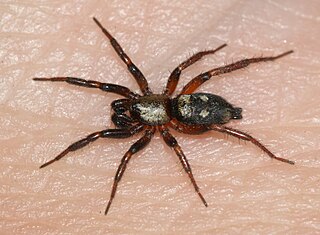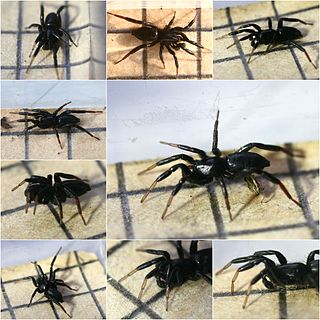
Xysticus is a genus of ground crab spiders described by C. L. Koch in 1835, belonging to the order Araneae, family Thomisidae. The genus name is derived from the Ancient Greek root xyst, meaning "scraped, scraper".

Habronattus is a genus in the family Salticidae. Most species are native to North America. They are commonly referred to as paradise spiders due to their colorful courtship ornaments and complex dances, similar to birds-of-paradise. Males display intricate coloration, while females are cryptic.

Cesonia is a genus of ground spiders that was first described by Eugène Simon in 1893.

Callilepis is a genus of ground spiders first described by Niklas Westring in 1874. Some are found from Mexico to Canada, others from Europe to India. They are most commonly found in dry areas, sandy roads and beaches.

Physocyclus is a genus of cellar spiders that was first described by Eugène Louis Simon in 1893.

Coneweb spiders (Diguetidae) are six-eyed haplogyne spiders that live in tangled space webs, fashioning a cone-like central retreat where they hide and lay eggs. It is a small family, containing only two genera split between a range in the Southwestern United States and Mexico and a range in South America. Members of the genus Diguetia usually build their webs in shrubs or between cactus pads. They have the same eye arrangement as the venomous recluse spiders.

Psilochorus is a genus of spiders in the family Pholcidae.

Bassaniana, commonly called bark crab spiders, is a widespread genus of crab spiders that was first described by Embrik Strand in 1928.

Micaria is a genus of ground spiders that was first described by Niklas Westring in 1851. They are 1.3 to 6.5 millimetres long.

Hololena is a genus of North American funnel weavers first described by R. V. Chamberlin & Willis J. Gertsch in 1929.

Drassyllus is a genus of ground spiders that was first described by R. V. Chamberlin in 1922.
Titanebo is a genus of North American running crab spiders that was first described by Carl Eduard Adolph Gerstaecker in 1933.
Anopsicus is a genus of cellar spiders that was first described by Ralph Vary Chamberlin & Vaine Wilton Ivie in 1938.
Modisimus is a genus of cellar spiders that was first described by Eugène Louis Simon in 1893.
Tolteca is a genus of Mexican cellar spiders that was first described by B. A. Huber in 2000.

Grammonota is a genus of dwarf spiders that was first described by James Henry Emerton in 1882.
Idionella is a genus of North American dwarf spiders that was first described by Nathan Banks in 1893.

Hentziectypus is a genus of comb-footed spiders that was first described by Allan Frost Archer in 1946. Originally placed with Theridion, it was moved to Achaearanea in 1955, and to its own genus in 2008. These spiders most resemble members of Cryptachaea, but are distinguished by a median apophysis that is broadly attached to the tegulum. Spiders of Parasteatoda have a median apophysis attached to the embolus, while those of Achaearanea have a hooked paracymbium on the pedipalps of males.

Mecaphesa is a genus of crab spiders that was first described by Eugène Louis Simon in 1900.













